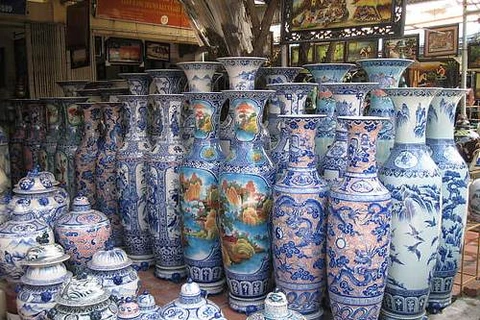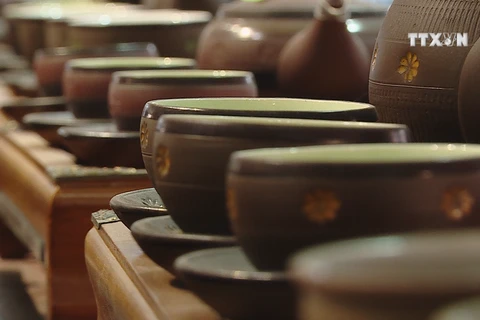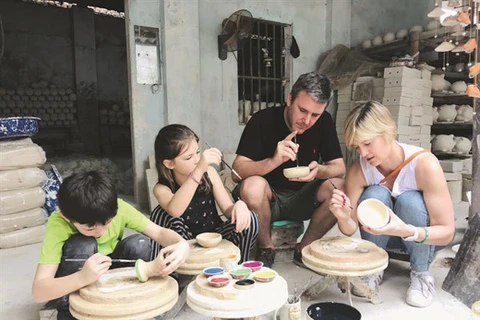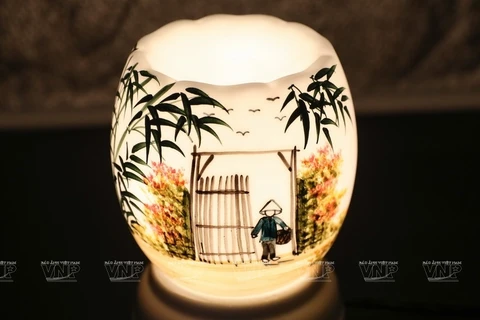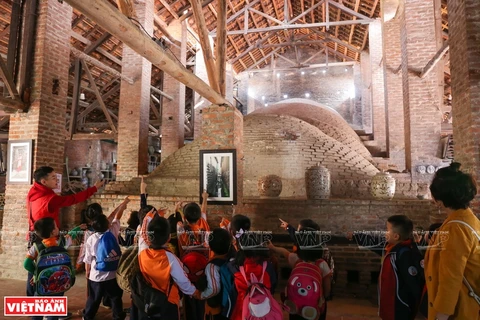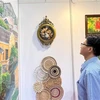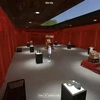 The ceramics museum, named the centre of Vietnamese craft quintessence, in Bat Trang village (Source: thanhnien.vn)
The ceramics museum, named the centre of Vietnamese craft quintessence, in Bat Trang village (Source: thanhnien.vn) Hanoi (VNA) – A ceramics museum is in its final stage in Bat Trang ceramics craft village – an ideal tourist destination in Hanoi, with its shape inspired by the local turntables and ancient kilns.
Architect Hoang Thuc Hao, deputy head of the Vietnam Association of Architects, said the facility, named the centre of Vietnamese craft quintessence, features curved surfaces, and optimises the use of the village’s traditional materials like ceramic bricks, baked roof tiles, and mosaic tiles.
The museum consists of two 4-storey buildings for exhibition and commercial purposes, with ceramic products in unique glazes and shapes made throughout the history of the village on display.
Ha Thi Vinh, Vice President of the Vietnam Association of Craft Villages, said she came up with the idea for the centre after visiting Japan where the One Commune One Product programme has been conducted efficiently, with the hope of making Vietnamese craft villages, particularly Bat Trang, better known in the market.
Vinh said digital solutions have also been prepared for the museum, adding that a scale model and 3D mapping of the village in 1953 – 1954 will be used to convey its historical story, while a virtual museum app will offer guidance and booking services for visitors.
Bat Trang commune is located in Gia Lam district, 10km from the city centre. It comprises Bat Trang and Giang Cao villages.
A century ago, people of Bo Bat village (now Yen Thanh commune, the northern province of Ninh Binh) followed King Ly Cong Uan from Hoa Lu to Thang Long - the new capital city (now Hanoi). They set up a pottery and brick-making ward on the banks of the Red River, which is now Bat Trang.
Bat Trang is well-known for the traditional pottery trade. There are approximately 200 enterprises and 1,000 households who produce and trade ceramic wares here, with the products exported to many countries such as Japan, the Republic of Korea, Thailand, Russia, Italy, and France.
In recent years, tourists have flocked to Bat Trang to look for traditional artefacts and buy ceramic wares. People also come to make pottery and go sight-seeing./.
| In October 2019, the Hanoi People’s Committee and the Vietnam National Administration of Tourism (VNAT) brought smart tourism to Bat Trang, further highlighting it on the capital’s travel map. Though the site has received tourists for a long time, official recognition as a tourist destination has brought more ambition and professionalism. A tourist information centre is available now at the entrance to support visitors and provide other services, including an audio tour in 12 languages, free maps, reservation for meals, bicycle hire and virtual reality experiences. There are many places to visit in Bat Trang, old houses like the one owned by artisan To Thanh Son, Tieu Dao Pagoda, Bo Bat old kiln, Kim Truc Pagoda, Giang Cao Temple and Mother Goddesses Temple. Apart from these relics, the core of Bat Trang commune is 23 traditional houses, 16 family temples and many old kilns, all built with Bat Trang bricks. In recent years, Bat Trang has received 200,000 visitors each year, according to Ly Duy Thanh, Vice Chairman of the Gia Lam District People’s Committee. “We acknowledge that the human factor is most important to preserve the traditional trade and develop the local tourism and economy,” he said. “The artisans with talent and high skill have made sophisticated products that bring good fame for the site. So we are determined that tourism development is based on the community." “Being involved in local life and learning to make pottery with skilled workers is attractive to tourists. That’s why local people play an important role. They are owners of the heritage.” |
VNA

